#stabilimenta
Text
This is a Yellow Garden Spider (likely Argiope aurantia) and as you can see it's very friendly! I let this one walk onto my hand from its web making sure not to harm the web itself. After taking some photos, I put it back. I saved these 2 pictures.
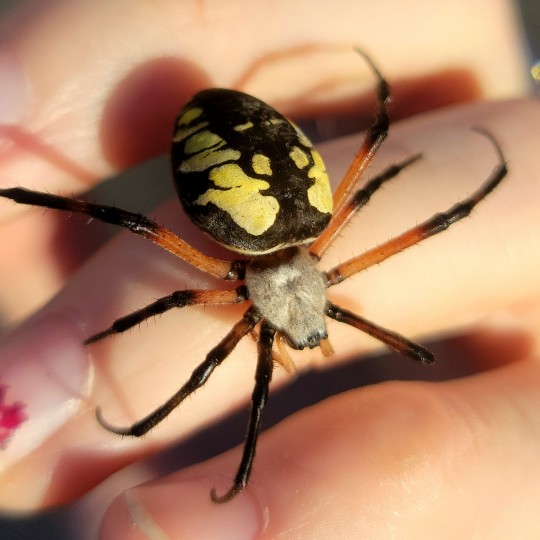
The term "Garden Spider" largely refers to spiders in the Families Araneidae and Uloboridae. They're also sometimes called Writing spiders or Zipper spiders. They are, of course, common in gardens and fields where people tend to plant things. So are many other kinds of spiders, but these in particular stand out due to their size, bright colors, and webs.
Like most spiders in your garden, they're harmless, friendly, and beneficial to have around. I wouldn't recommend trying to pick one up just for fun - I let this one walk on to my hand itself, and am using these photos for educational purposes. But, they are fun enough to just look at and watch, I think!
There are also many unique traits they have that separate them from your "typical" web-spinning spider. I don't have a picture to show you, but look up "writing spider webs" if you're interested!

What about them is so special? Well, assuming you just looked at pictures of their webs, there's a reason they're called Writing (or Zipper) spiders.
The thicker silk stands on a Garden spider's web are called Stabilimenta, but we're not really sure what their purpose is. It was initially thought they were to support the rather large spider, but their webs can still hold up even when the Stabilimenta are cut. The leading hypothesis is that they repel birds - the thicker web is easier to see, and so birds will notice it and NOT fly through the web, wrecking all the spider's hard work. Likewise, birds don't seem to prey on these spiders, meaning the extra attention is entirely welcome for the spider.
They probably don't want their webs wrecked more than other spiders, too, because they don't deconstruct them. Many outdoor spiders move often - eating up and rebuilding their web somewhere new - sometimes as often as every night! Zipper spiders rarely move their web unless it's an emergency, or a matter of catching more food. As such, building their webs is costly in terms of silk and energy, so they might've evolved the Stabilimenta to ensure their web's longevity.
As a closing note, they are not dangerous at all. People have been dumber than birds before and walked head-first into the webs of these spiders, but even then, they don't bite. Even if they did, their venom is mild, and you probably won't even notice you've been bit until a light rash forms later.
Most of the time, they will build their webs out of the paths of larger animals (that's you!), and even if they do, it's not going to hurt you. It's best to leave them there, too, since they'll eat pests for you. If you're planting things and see one of these spiders, consider yourself lucky. They are colorful and gentle defenders of your plants who simply wish to coexist with you peacefully.
#bugs#bug#nature#insect#insects#entomology#forest#entymology#invertebrates#photography#spider#spiders#garden#arachnid#arachnids#bug facts#the creature#garden spider
308 notes
·
View notes
Photo

Argiope bruennichi (wasp spider), i think, somewhere in France, time stamp says in September if I am to believe it... And my thumb next to it for size reference, of course.
Fact taken from the wikipedia page: The spider builds a spiral orb web at dawn or dusk, commonly in long grass a little above ground level, taking approximately an hour. The prominent zigzag shape called the stabilimentum, or web decoration, featured at the centre of the orb is of uncertain function, but it has been shown that webs containing stabilimenta catch fewer insects because they are less cryptic, but on the other hand these webs are less often damaged by birds flying through them.
( @onenicebugperday if you don’t mind confirming this one as well ^^;?)
156 notes
·
View notes
Text


The Form and Function of Spider Orb Webs
: Evolution from Silk to Ecosystems
Stabilimenta in spider orb webs
(A–C) various morphologies of silk stabilimenta in the webs of Argiope argentata (Costa Rica). (D) Spiral silk stabilimentum in the horizontal orb web of Uloborus glomosus (USA). (E) Curled leaf ‘stabilimentum’ in the web of an unidentified araneid (New Britain). (F) Debris stabilimentum at the hub of the web of Cyclosa caroli (Costa Rica). The spider is sitting at the centre of its hub and its horizontal orientation matches that of the stabilimentum. (G–I) Stabilimenta are commonly included in the resting webs built by spiders preparing to moult or lay eggs. (G) Nephila clavipes (Costa Rica). (H) Argiope argentata (Costa Rica). (I) Cyclosa caroli (Costa Rica)
Theridiid cobwebs and linyphiid sheetwebs
(A–B) the cobweb of Parasteatoda (Achaearanea) valoka from New Britain. The web is unique in how a leaf is bent over and used as the substrate for the entire web, yet it illustrates common themes of typical cobwebs—a central to peripheral irregular sheet forming a retreat for the spider with sticky gumfooted threads radiating from it and attached to the substrate (A), with sticky globules restricted to the lower part of the gumfoot lines (B). (C) a ‘star web’ (Achaearanea sp. juvenile) as built by many Achaearanea/Parasteatoda species, with a semi-global central retreat, and radiating gumfoot lines. The spider rests in the centre of the ‘globe’ and seems well protected from larger predators. (D) Theridion sp. that spins a simple two-dimensional sheet with sticky globules distributed throughout the sheet. The spider has a silk retreat under the leaf. (E)Helvibis cf. thorelli, with long gumfoot lines radiating from a silk retreat under a leaf. (F) subsocial web of Anelosimus may, a ‘basket’ shaped sheet web with knockdown lines above the sheet. No sticky silk seems to be employed. The spiders rest under leaves in the basket area and seem well protected from larger predators. (G) sheet web of Dubiaranea sp. (Linyphiidae) (photograph courtesy of W. Eberhard)
24 notes
·
View notes
Text

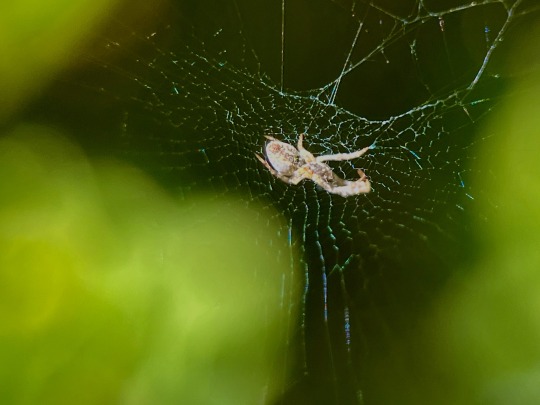

CRIBELLATE ORB WEAVER (Uloboridae), genus Uloborus
Found a few of these in a little apartment complex made of multiple horizontal webs in a gap between bushes; my first ever encounter with this orb weaver family (I’ve only seen Araneidae and Tetragnathidae so far).
[Uloboridae information under cut]
The cribellate orb weaver:
Does not have venom glands!
Web is not sticky; they spin a weird, fine silk “back-combed” by a movement they make with their legs while spinning, which entangles insects’ legs as they walk over it.
Creates HORIZONTAL webs with stabilimenta (thick scribbly or zig-zag lines through the web; this is thought to provide camouflage, attract prey, and/or help make the web visible so it won’t be accidentally destroyed by diurnal animals).
Enjoys being impossible to photograph by impersonating a dead leaf 24/7. Never once caught it breaking that position. One time it even let its abdomen dangle and pretended to blow in the breeze like “nothing to see here; I am merely web trash”
#spiders#spider#cribellate orb weavers#hackled orb weavers#Uloboridae#my photos#not really proud of that in this case but I did my best lol
9 notes
·
View notes
Text
Obey Me! boys as SPIDERS bc this is my blog and I get to inflict my interests upon this website with it
Spider assignments are based on both behavioral suitability and appearance, and the descriptions I’ve included are a mix of relevant and general info
(Tw for images of real spiders – many are taken from SpiderID, a site for photographing, identifying, and sharing info about spiders! I highly recommend paying a visit if ur interested in arachnids. Credits for spider photos not from SpiderID are listed after each entry.)
Lucifer – Inland Black Button Spider (Latrodectus renivulvatus)

✧ If you thought I was gonna be predictable and pick a widow spider for Lucifer, then you were correct! Tho honestly Lucifer fits the genus Latrodectus just…[waves hand] in general, that’s still ≈34 different species. Based on nothing but vibes and aesthetics, I feel like the inland black button spider specifically matches Lucifer the best.
Latrodectus spiders are well-known for their painful bites, something they owe to the neurotoxin in their venom (appropriately dubbed latrotoxin). "Wet” bites are rarely fatal to humans unless underlying health issues are present, but the symptoms still suck. These spiders are not aggressive towards humans, though they may bite defensively if they feel trapped or otherwise threatened.
✧ Honorable mentions: peacock jumping spider, peacock parachute spider
(Photo credit: Ludwig Eksteen)
Mammon – Wasp Spider (Argiope bruennichi)

✧ Most spiders of the genus Argiope add a particular flair to their webs in the form of zigzagged, UV-reflective, banded silk patterns referred to as stabilimenta. Stabilimenta are spun in such a way to form an X shape on the web, at the center of which the spider sits and waits for prey. It’s unclear what purpose stabilimenta serve, though the main theories are that it can both lure insects into the web and help keep larger creatures from accidentally stumbling through it.
The venom of Argiope spiders is not dangerous to humans, though it can still cause redness and swelling around the bite area. Also, the bites still hurt like a bitch. These spiders seldom bite larger, non-prey animals unless directly grabbed.
✧ Honorable mentions: golden silk orb-weaver
Leviathan – Euophrys monadnock
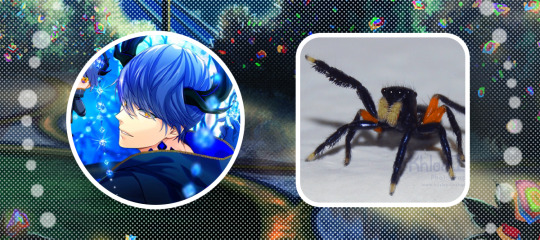
✧ Jumping spiders (family Salticidae) are the most populous type of spider in the world, with over 6,000 species currently on-record. They’re also very cute, as you can see! Unfortunately, many of these species are seriously under-researched. For example, we know Euophrys monadnock was first described in 1891 by American arachnologist James Henry Emerton, and we know it can be found in the U.S. and Canada…but there isn’t much else readily available. It could be postulated that this species prefers higher altitudes, which seems to be common for spiders in the genus Euophrys – the Himalayan jumping spider (E. omnisuperstes) can be found thriving on Mt. Everest at elevations of over 20,000 ft.
“Waving” is a common action seen in jumping spiders, and it can act as a means of signaling to others of their species, for courtship purposes, or simply to get a better “feel” for their surroundings. There are a number of other jumping spiders on this list, so I’ll end this entry here and save the rest for the other entries.
✧ Honorable mentions: Castianeira amoena, ladybird spider
Satan – Emerald Jumping Spider (Paraphidippus aurantius)
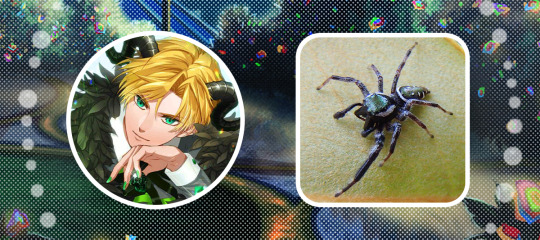
✧ Well would you look at that, another jumping spider! Spiders of the genus Paraphidippus are noted as being fairly large for jumping spiders, though not as large as those of the genus Phidippus, from which they get their name. This species can be found throughout Central America, Mexico, and in some parts of the U.S., as well as throughout the Greater Antilles.
Jumping spiders have exceptionally good eyesight for spiders, so it’s unsurprising that most of them are diurnal hunters who actively search for and stalk prey. That isn’t to say none of them spin capture webs; it’s just uncommon, and those that do usually still go hunting beyond their web. Some employ the classic “wait for food to come to you” technique even without a web at all. Jumping spiders are primarily solitary hunters and will engage in opportunistic cannibalism towards other spiders, fellow salticids or not.
✧ Honorable mentions: green lynx spider, decorative silver orb-weaver
Asmodeus – Pink Crab Spider (Thomisus onustus)

✧ Despite being called the “pink” crab spider, Thomisus onustus is capable of changing its color to help it blend in with the flowers which it calls home. This process takes time and energy to complete, though, so it tends to stick to flowers it’s already similar to. Along with some other species of crab spider, the pink crab spider can and will eat plant pollen when its usual insect prey is unavailable; this isn’t a long-term solution, however, and a lack of “proper” nutrition will cause them to stop molting.
Thomisus onustus is unusual amongst crab spiders due to how it tends to lie in wait at the center of flowers, as opposed to situating itself on the flower’s petals. It also displays possibly the most striking case of sexual dimorphism in the family Thomisidae, with the females being approximately 60 times larger than the males.
✧ Honorable mentions: scorpion-tailed spider, Alpaida gallardoi
Beelzebub – Gasteracantha falcicornis

✧ Sometimes referred to as “crab spiders” due to their crablike shape, spiny orb-weavers (genus Gasteracantha) are not actually very close to ‘true’ crab spiders (family Thomisidae) on the taxonomic tree. Speaking of which, Gasteracantha has a pretty complicated taxonomic history! This is due in no small part to the diversity of coloration and spine/spike length within individual species. It’s unclear what purpose these spines serve, though it’s been proposed that it helps them look like stray seeds or thorns caught in their webs, helping conceal them from predators.
Spiders of the genus Gasteracantha can be found in tropical/subtropical zones throughout the world, but Gasteracantha falcicornis specifically makes its home in eastern and southern Africa. Orb-weaver bites are comparable to bee stings in terms of pain, but are otherwise harmless to humans.
✧ Honorable mentions: long-winged kite spider, Mexican rust-leg tarantula
(Photo credit: Wikimedia Commons)
Belphegor – Sphodros abboti
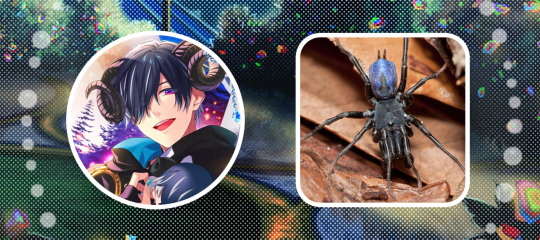
✧ The backs of Sphodros abboti are distinctly purple, though the males have more of a blueish hue to them. This species also only has two eyes for some godforsaken reason. Spiders of the family Atypidae, to which Sphodros belongs, are referred to as purseweb spiders or atypical tarantulas. Sphodros was considered synonymous with its sibling genus Atypus until 1980.
Purseweb spiders get their name from their unusual webs, which resemble tubes or socks. As you can probably guess, these little guys are ambush predators! They lie in wait at the entrances of their webs, where they grab and yank in unsuspecting prey. Their webs (or the inner linings, at least) have a history in human medicine, being cut up and used like gauze to dress wounds.
✧ Honorable mentions: Heteropoda lunula
(Photo credit: Daniel Dye, Georgia Biodiversity)
Diavolo – Mexican Flame-knee Tarantula (Brachypelma auratum)
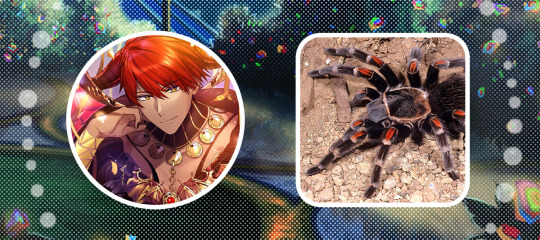
✧ They’re big, they’re iconic, and they’re a common sight in the illegal trade market for tarantulas – it’s the genus Brachypelma! Like most tarantulas, these dudes are cannibals and have to be kept separate. They rarely bite humans, but they don’t really need to; they can kick urticating hairs at threats, which proceed to lodge in the skin/eyes of the target and cause significant topical irritation.
Though many spiders in the genus Brachypelma are known to eat frogs and lizards in addition to insects, the Mexican Flame-knee Tarantula has been observed living together in a symbiotic relationship with the frog species Eleutherodactylus occidentalis. The spider keeps the frog safe from other potential predators, and the frog eats ants and other small insects that might make a meal of the spider’s eggs.
✧ Honorable mentions: most red-colored Brachypelma species tbh
Barbatos – Fighting Spider (Thiania bhamoensis)

✧ This species of jumping spider possesses a lovely iridescent teal coloration! They also absolutely cannot STAND each other. Male specimens of Thiania bhamoensis will fight each other with little hesitation, earning them the name “fighting spider.” They’re a common sight in spider fighting matches in Singapore, Malaysia, and other parts of Southeast Asia.
Like most jumping spiders, Thiania bhamoensis does not spin capture webs. They do, however, build little retreats by using their silk to sew leaves together, which is pretty unusual behavior for salticids. These nests are frequently but not exclusively found on spider lilies (Crinum asiaticum), and they make for the perfect hiding spots for the spiders to rest, molt, and lay eggs.
✧ Honorable mentions: Cosmophasis thalassina
Simeon – Common White-flanked Water Spider (Nilus albocinctus)

✧ Was tempted to assign this one to Solomon, seeing as he’s written a book about fish and claims to know a lot about marine ecosystems, but I feel like the coloration fits Simeon better. As you can probably guess, Nilus albocinctus is also called the fishing spider, dubbed so due to its practice of catching and consuming small fish. They do not construct capture webs.
Like many spiders in the family Pisauridae, this species is able to traverse still waters by walking across their surface, and can briefly dive both to capture prey and escape enemies. Being under the umbrella of “nursery web spider,” female specimens of Nilus albocinctus construct and carry an egg case under them until the eggs are about to hatch, upon which they set up an egg “tent” and stand guard until hatching time.
✧ Honorable mentions: ornamental tree trunk spider
Luke – Woolly Jumping Spider (Ballinae sp.)

✧ If any spider on this list winds up being fake, it’s probably going to be this one. The only source I can find is Facebook user Vida van der Walt’s 2014 post (which this image is from), and Ballinae is…something of a contested subfamily, to my understanding. However, like I mentioned earlier, there are a fuckton of officially defined jumping spider species, and countless more that have yet to be properly recorded.
This exceptionally fluffy little guy was reportedly spotted in Mount Coke State Forest, South Africa.
✧ Honorable mentions: goldenrod crab spider
(Photo credit: Vida van der Walt)
Solomon – Mirror Spider (Thwaitesia argentiopunctata)
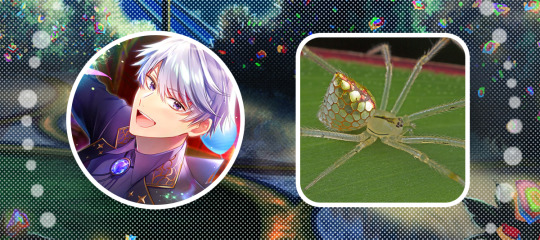
✧ Also known as the sequined spider, this tiny species can be found across Australia. Other spiders of the genus Thwaitesia can be found in tropical zones the world over. The shiny, reflective ‘scales’ on its abdomen are made of guanine and are reactive to the spider’s stress levels; they will shrink or grow depending on if the spider feels threatened.
This species is part of the diverse, globe-spanning family Theridiidae, also known as comb-footed spiders or “those bastards who won’t get out of your house.” Spiders of this family are literally THE most likely to pop up in your home uninvited.
✧ Honorable mentions: Gasteracantha diardi
(Photo credit: Andrew Ker)
✧ Bonus ✧
Thirteen – Brazilian Pinkbloom Tarantula (Vitalius wacketi(?))

✧ Due to its impressive coloration, this species is pretty in-demand as a pet amongst tarantula enthusiasts! Unfortunately, that also means there’s a lot of misinformation about it out there. Some people claim that it has a calm temperament and isn’t bothered by human presence, while others claim that it’s naturally hostile and prone to biting.
You might notice :) that little question mark in the scientific name :) well it’s bc I can’t get a straight answer about what genus this thing is in. Most sources continue to list it as Pamphobeteus sp. platyomma, which makes sense considering its large size (befitting of the genus Pamphobeteus). However, it was apparently recategorized under the genus Vitalius a while back, alongside…literally a third of the species listed under Pamphobeteus lmfao?
✧ Honorable mentions: batik golden web spider, Jorō spider
(Photo credit: RTTScience)
Mephistopheles – Purple-Gold Jumping Spider (Simaetha sp.)
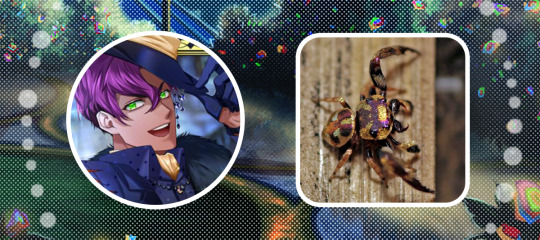
✧ Another spider without much information on it, sadly, though that stunning coloration certainly makes up for it. The genus Simaetha, namesake of the genus Simaethula, was first described in 1881 by Swedish arachnologist Tamerlan Thorell. These spiders are exclusive to Asia, Australia, and Papa New Guinea. This species, specifically, was reportedly spotted in Saraburi, Thailand.
Simaetha is part of the subfamily Salticinae, which includes most species of jumping spider. There are a few features that set this subfamily apart from the others, one of which being their gait, which is more irregular and abrupt than salticids of other subfamilies.
✧ Honorable mentions: none. WHO else could compare, truly.
(Photo credit: Project Noah)
Raphael – Oval St. Andrew’s Cross Spider (Argiope aemula)

✧ Listen. What does this one lack. It’s got the right coloration. It’s got a religious reference in its common name. It’s in the same genus as Mammon’s spider. What more does it need.
The genus name Argiope literally means “silver face/head,” regarding the silvery hairs the spiders of this genus possess. Though the “oval” part is unique, the “St. Andrew’s Cross” part of its name is something Argiope aemula shares with multiple other species in its genus. This part of its name is derived from the X-shaped pattern seen in Argiope webs, which resembles the X-shaped cross on which St. Andrew is said to have been crucified.
✧ Honorable mentions: none
Henry 2.0 – Orange Tortoise Spider (Encyosaccus sexmaculatus)

✧ Just a lil guy :)
This is another one without much info, but it’s been known about for a while now – it was first described in 1895 by French naturalist Eugéne Simon. The most recent Academic Report™ I could find on it was a 1996 Harvard publication by Herbert W. Levi.
✧ Honorable mentions: none
(Photo credit: arachnoboards user Asser)
#obey me#obey me shall we date#spiders#arachnids#lucifer#mammon#leviathan#satan#asmodeus#beelzebub#belphegor#lord diavolo#barbatos#simeon#luke#solomon#thirteen#mephistopheles#raphael#henry 2.0#little d no. 2 speaks#little d no. 2 edits
58 notes
·
View notes
Text

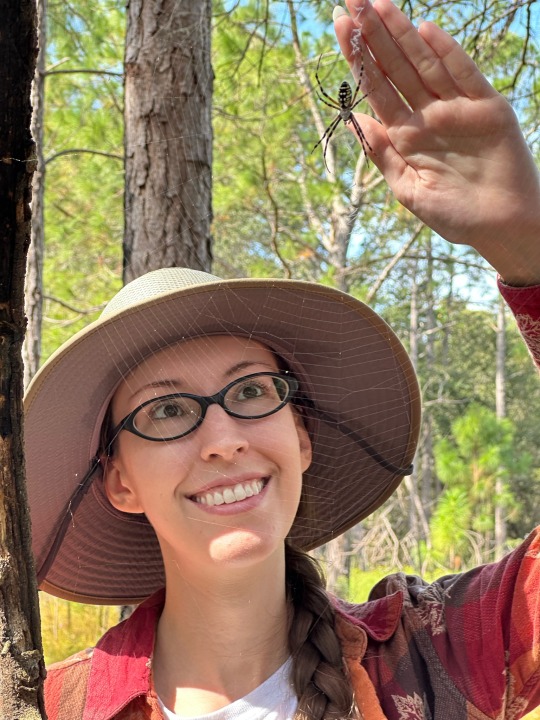
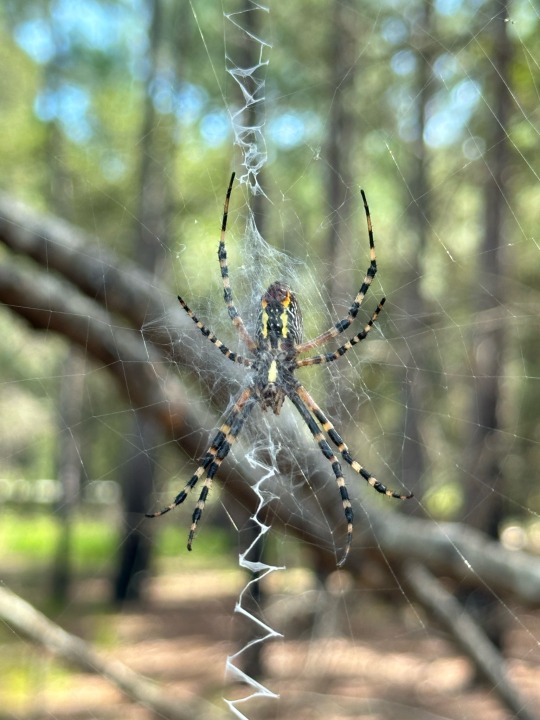

Yet another spider selfie 🤷♀️ This species is Argiope aurantia. They can get fairly juicy (see the second pic with my hand for scale), but they are not harmful to humans and will only bite if provoked.
🕷
I sometimes get asked about spiders who have a section of their web that is thicker with a zigzag pattern. You can see this really well in the closeup shots here. That segment of the web is called stabilimenta.
🕷
As you can probably tell from the name, one of the past theories of their purpose was to add extra strength and structure to a spider’s web. The exact purpose is still disputed, but I’ve also heard that they help make the web more visible so that birds don’t fly into them. Other hypotheses of the stabilimenta’s purpose is that they act as camouflage for the spider, or that they somehow attract insects.
🕷
I only learned recently that stabilimenta are only constructed by spiders that are active during the day. (I assume this is why the idea that they are there for structural integrity is no longer a top contender.)
🕷
It’s incredible to me that there are sooooo many parts of nature that we don’t have answers for. It’s a reminder that we need to protect the natural world because there is a lot we have to learn from it (and one of the things that we are constantly learning is that humanity’s dependence on natural ecosystems is even stronger than much of the western world previously understood).
🕷
📍Lake Louisa State Park
#florida #arachnid #spider #argiope #argiopeaurantia #macro #nature #naturelovers #nature_brilliance #fiftyshades_of_nature #arthropod #invertebrate #gardenspider #Araneidae #web #spiderweb #spiderselfie
@lake.louisa.state.park @fl.stateparks
0 notes
Text

The spiders use their specialized silk strands called stabilimenta to arrange the debris along.
#spider #spiders #arachnids #arachnid #nature #naturefacts #spiderfacts #factoftheday #learning #education #til #facts #funfact #learn #discover #funfacts #todayilearned #factsdaily #knowledge #todayilearnedthat #lessonoftheday #science #sciences #scienceiscool #spidersoftheworld #spidersarecool #decoy #stealth
1 note
·
View note
Photo
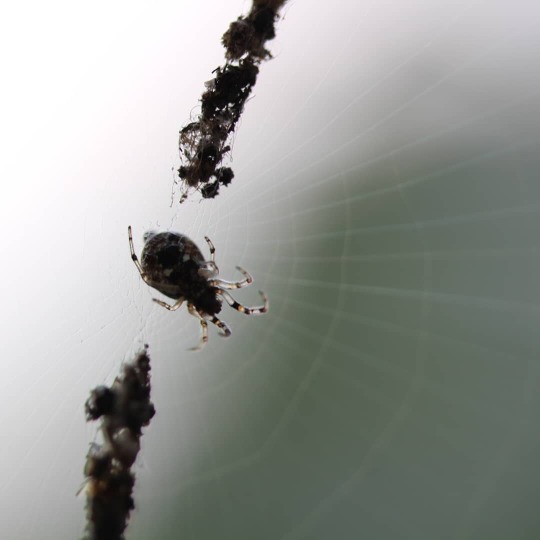
Humped Trashline Orbweaver (Cyclosa turbinata) at my parents' house. Cyclosa spiders incorporate the outer husks of their insect prey into a line of sticky silk that runs across the center of their web. The spider themselves hides within this lone of debris and dead insects and waits for prey to get caught in its web, then rushes out to feed. The "trash line" appears to camouflage them from bird predators, making the spider difficult to find among the trash. . . . . . . . I have to say it: Boba Fett used this technique in Star Wars: Empire Strikes Back to hunt down the Millennium Falcon. You were all thinking it 😏 . . . . . . . #nature #ontario #ontariospiders #cyclosa #cyclosaturbinata #orbweaver #trashline #trashlineorbweaver #stabilimenta #spiders #spiderphotography #macrophoto #macrospider #macronature #macro_world #invert_macro #naturalhistory #ontarionature #arachnidsofinstagram #starwarsreference #starwars #bobafett #norfolkwild #blognorfolk #norfolkcounty #naturephoto (at Norfolk County, Ontario) https://www.instagram.com/p/CDQsiYIAAtR/?igshid=17f1qbfjn958v
#nature#ontario#ontariospiders#cyclosa#cyclosaturbinata#orbweaver#trashline#trashlineorbweaver#stabilimenta#spiders#spiderphotography#macrophoto#macrospider#macronature#macro_world#invert_macro#naturalhistory#ontarionature#arachnidsofinstagram#starwarsreference#starwars#bobafett#norfolkwild#blognorfolk#norfolkcounty#naturephoto
0 notes
Note
A thing I've wondered, why do some spiders have a funky lil zigzag line in their web? There's this whole web, almost not visible, and then this very visible and chonky zigzag thing at one spot for some reason. Sorry if this wasn't specific enough, I've never been good at describing things. Hope you have a nice day though!
It's called a stabilimentum, and they come in lots of different shapes depending on the species of spider! "Zigzag spider" or "zipper spider" are common names for the yellow garden spider, Argiope aurantia, because of their stabilimenta, so most people are familiar with them, I think! The purpose is still debated, though. I've read a bunch of papers about it over the years, and I don't know what the leading theory is anymore, but past theories have included web stabilization (found to be unlikely), camouflaging the spider itself, which normally sits in the middle of the web and thus in the stabilimentum, making the web visible to animals like birds who might otherwise destroy it (seems counter-productive? why would you want a predator to know where you are?), and finally prey attraction, possibly by reflecting UV light, which insects are attracted to.
So...I don't have a good answer for you, and apparently neither do arachnologists :P
113 notes
·
View notes
Photo


Some species of spiders have developed a behavior of creating web decorations called stabilimenta, which were originally thought to help stabilize the web. Species like Argiope aurantia create an impressive zigzag platform to stand on, often appearing to float in the center of an otherwise inconspicuous web. There have been many reasons proposed for these decorations, the most likely of which is reflecting UV light to attract insects. This is not the reason that Occam's razor would likely pick, but the natural world is highly complex.
79 notes
·
View notes
Note
You are incredible and i love you platonically Also can we have more spider stories please i am trying to get over my fear of them as i am trying to love all my creepy crawly buddies and the spider brush was cute
That is very sweet and I am happy to provide more spider stories.
My favorite spider species is Argiope aurantia, the golden garden spider, also known as the zipper spider. I once collected one for an educational program and kept her through the winter until she constructed a huge egg sac and expired a couple of weeks later. She was a delight to have around and it was very fun to watch her hunt crickets. My friends named her Veronica.
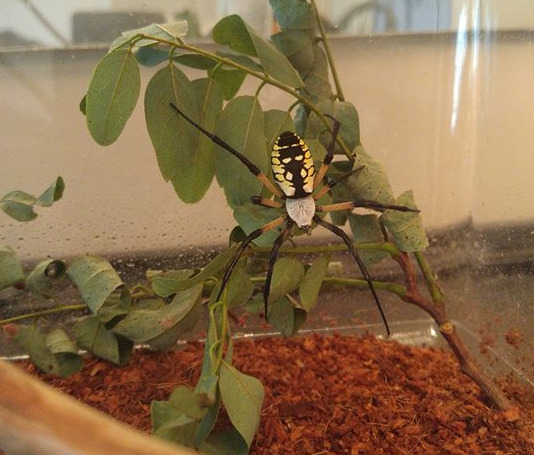
Zipper spiders are so named because of the unusual structure they build in the center of their webs called a stabilimentum, which resembles a zipper. The function of stabilimenta is somewhat uncertain ... though the original hypothesis that they are for structural integrity (hence the name) seems to have been disproven. As nocturnal spiders don’t make stabilimenta, their purpose is probably visual. Prevailing theories include the attraction of prey, camouflage for the spider, and making the web more visible to large animals that might inadvertently crash into it and destroy it.
Veronica consumed her old web and built a new one every two or three days. She preferred to do this in the early morning, when nobody was watching her.

After Veronica laid her eggs, I kept her egg sac until spring, at which point I placed it on the porch of one of the historic cabins at the park where I was working. A few weeks later, I inspected it one morning and found it cracked and hollow, her children having hatched out of it and crawled away.
168 notes
·
View notes
Photo

Argiope amoena, (Kogane-gumo) (”Golden Spider”)
“In North America, Argiope aurantia is commonly known as the black and yellow garden spider, zipper spider, corn spider, or writing spider, because of the similarity of the web stabilimenta to writing.The East Asian species Argiope amoena is known in Japan as kogane-gumo. In the Philippines, they are known as gagambang ekis ("X spider"), and gagambang pari ("priest spider", due to the spider's body resembling a priest's head with a mitre).
The average orb web is practically invisible, and it is easy to blunder into one and end up covered with a sticky web. The visible pattern of banded silk made by Argiope is pure white, and some species make an "X" form, or a zigzag type of web (often with a hollow centre). The spider then aligns one pair of its legs with each of the four lines in the hollow "X", making a complete "X" of white lines with a very eye-catching spider forming its centre.The zigzag patterns, called stabilimenta, reflect UV light.[3] They have been shown to play a role in attracting prey to the web, and possibly in preventing its destruction by large animals. The centres of their large webs are often just under 1 metre above the ground, so they are too low for anything much larger than a rabbit to walk under. The overtness of the spider and its web thus has been speculated to prevent larger creatures from accidentally destroying the web and possibly crushing the spider underfoot.“ --Wikipedia
These garden spiders can grow to intimidating size (as shown above) and can spin webs that span a creek, sidewalk, or garden path, which is as startling as you may imagine for both the spider and the human trying to traverse the sidewalk. However, the Kogane-gumo is a lovely and helpful predator friend who will pick her territory and stick to it, not wanting to run across anybody’s bed at night like her cousin the cheeky Huntsman.
Kogane-gumo are most often found in the summer time after hatching, where they will spread away from their hatching site and set up little webs along the same stretch of road or shrubbery and then grow fat during the warm season.
Further reading: Link
4 notes
·
View notes
Photo
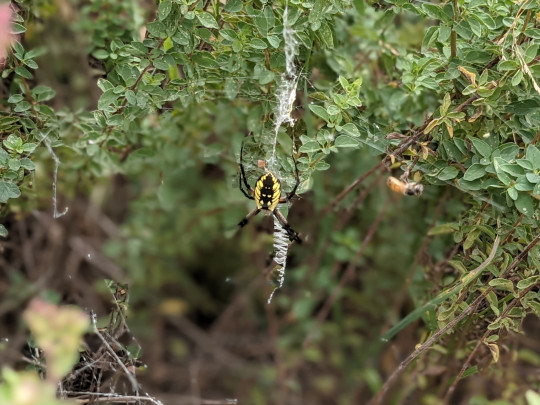
A new snapshot from https://sagesacre.com/2021/08/13/zipper-spider-in-the-oregano/
Zipper Spider in the Oregano
Black and Yellow Zipper Spider (Argiope aurantia)
The Acre is thick with giant spiders this time of year (nothing so invigorating as a mouthful of web and spider at sunrise).
Most are your run-of-the-mill orb-weaver spiders, fat bodied things that build enormous webs. But every so often I run across the much more impressive zipper spider, a big, black and yellow spider that builds a basket-shaped web much closer to the ground than the orb weaver.
It’s called a “zipper” spider because it makes a zig-zag portion of the web known as a “stabilimenta“, that either stabilizes the web, draws prey to the web, draws predators to the spider, or all of the above or something else, depending on whom you believe.
Regardless of the reason, the important part is that it looks like a zipper.
Anyway, I spotted this zipper spider in a patch of flowering oregano. It already had several moths tied up, which is why I think it was ignoring the bees caught in its web. Good for it. A nice spider.
0 notes
Photo

Yellow garden spider or zigzag spider (and known by many other names), scientific name of Argiope aurantia often build webs in areas adjacent to open sunny fields where they stay concealed and protected from the wind. The web of the yellow garden spider is a circular shape up to 2 feet (60 cm) in diameter, with a dense zigzag of silk, known as a stabilimentum, in the center. The purpose of the stabilimentum is disputed. It has been speculated that it acts as camouflage for the spider lurking in the web's center, but it may also attract insect prey, or even warn birds of the presence of the otherwise difficult-to-see web. Only those spiders that are active during the day construct stabilimenta in their webs. The yellow garden spider can oscillate her web vigorously while she remains firmly attached in the center. In a nightly ritual, the spider consumes the circular interior part of the web and then rebuilds it each morning with fresh new silk. The radial framework and anchoring lines are not usually replaced when the spider rebuilds the web. The spider may be recycling the chemicals used in web building. Additionally, the fine threads that she consumes appear to have tiny particles of what may be minuscule insects and organic matter that may contain nutrition. #spider #web #spiderweb #wildlife #outdoors #outdoorphotography #arachnid #predator https://www.instagram.com/p/B0bzHzQgBBy/?igshid=1wiv4hqvtvl16
0 notes
Photo

Yellow garden spider I think. Look at her neat stabilimenta!
0 notes